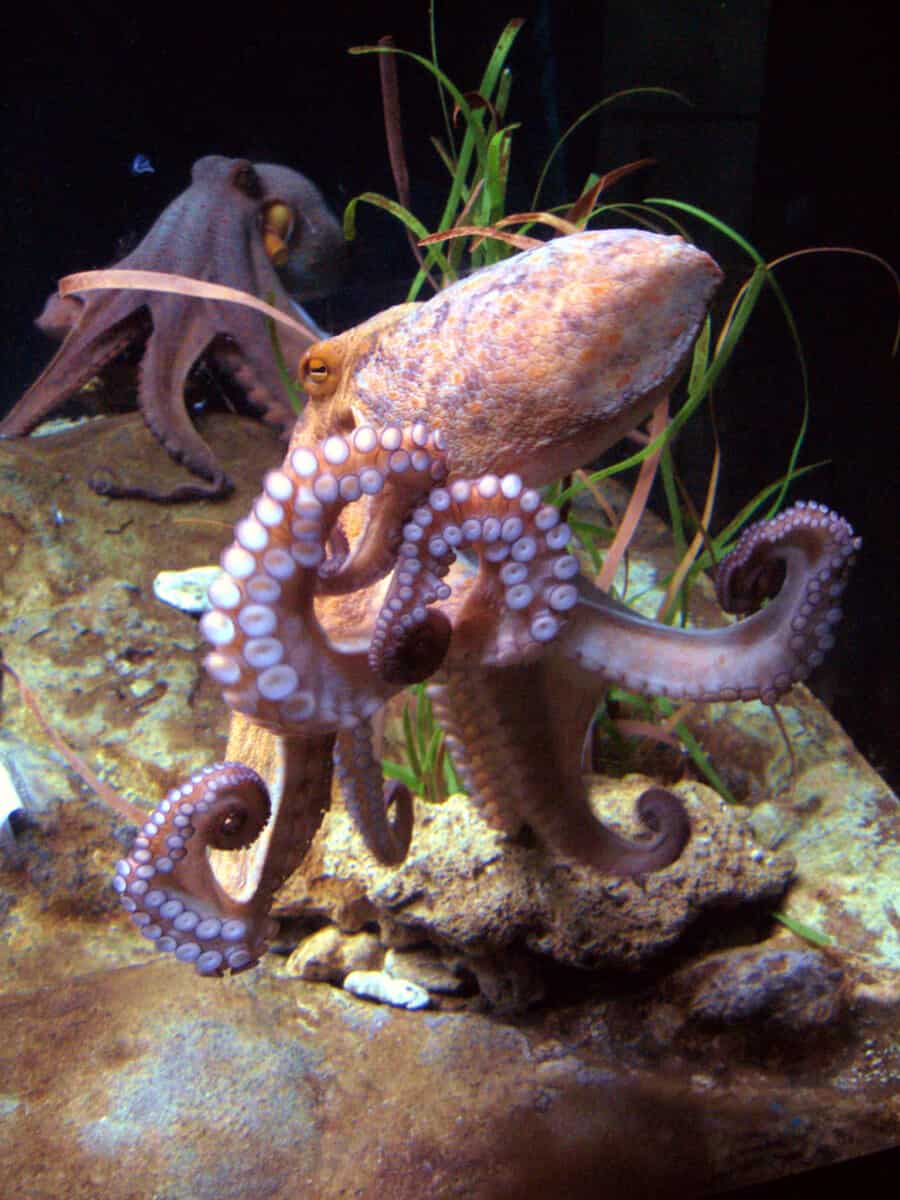Octopuses can regenerate entire arms, even though each arm has a mini brain and an extensive network of neurons. Healing begins with undifferentiated stem cells that develop into specialized cells, such as the nerve and muscle cells of a new arm. Regenerated arms are as good as new and perform as fully functional replacements for the original arms.
Octopuses have the unique ability to regenerate a fully functional arm in about 100 to 130 days. Several animals can regrow appendages, but with most species the new appendage is not quite as good as the original. Lizards, for example, can regrow their tails using special, undifferentiated cells, but the new tails are usually inferior to the originals.
Octopuses can regrow arms that are just as good as the original and fully functional in every way.
The incredible regenerative abilities of cephalopods have fascinated researchers for over 160 years. Cephalopods, including various species of cuttlefish, squid, and octopus, are all capable of regenerating a variety of damaged tissues, including appendages, peripheral nerves, and even parts of the central nervous system.
This is a remarkable ability, when you consider that the regenerated bits recover both the structure and function of the missing tissues and become indistinguishable from the original structures.
What Makes an Octopus Arm so Impressive?
Octopus arms are not like yours or mine. OK, I admit that human arms ARE pretty amazing, with our intricate networks of nerves, muscles, bones, and blood vessels. But octopus arms are even more complex in some ways, considering that each arm literally has a mini brain of its own (see my article on Why Octopus have 9 Brains).
Every time an octopus regenerates an arm, it must regrow a whole new mini brain along with an associated network of up to 40 million neurons. I wish I could do that!
It is difficult for us to comprehend how 9 brains could work together. Well, the octopus shows us exactly how effective such a nervous system can be, with a mini brain in each arm and a slightly larger central brain in the head. You know the old saying how “two heads are better than one.” I guess the octopus equivalent would be “9 brains sure beat the hell out of one lonely little set of overworked ganglia!” (Just so us single-brained humans don’t get too uppity).
I’m always impressed and deeply humbled when I consider that cephalopods, including the earliest ancestors of the octopus, have been around for over half a billion years (530 million)! It just shows you that the arrangement of 9 brains has served the octopus well through the thick and thin of the five mass extinctions that have taken place during that time and the countless Millenia of change. Modern humans have been around for roughly 200 thousand years, and for how much longer is debatable!
For a “taste” of how 9 brains work together let’s consider a recent set of experiments by Italian researchers (Fossati et al, 2013). The researchers captured six octopus and chopped off pieces of their arms. Even when an entire arm was removed, they found that the mini brains remained in control and the arms continued to act independently. If you give a severed arm something tasty, it will even try to deliver food to where its own beak would be – or should be! Now that is impressive! But sad.
An octopus’s severed arm can continue to act independently for several minutes, even if the head, with its central brain, has been euthanized. Of course, it is just a matter of time before the severed arm dies since the circulatory system can’t deliver oxygenated blood.
So, when an octopus regenerates an entire arm, it is doing something more complex and awesome than simply regenerating muscle tissue. Each arm has roughly 40 million neurons that have to be replaced, along with all the blood vessels, muscle tissue, connective tissue, and a complex array of skin cells and chromatophores that allow the octopus to display a wide spectrum of colors.
(BTW, starfish are probably the champions of regeneration. In addition to being able to regenerate one or more arms, starfish can regrow an entire new body from just one arm! Now that takes some hi-powered regenerative ability!)
How Does an Octopus Regenerate its Arm?
There’s an incredible amount about the regenerative process that we don’t understand. What we do know is that it involves renewing, restoring, and growing new cells, tissues, and even organs to replace those that have been lost. The biochemical and biophysical mechanisms involved make suitable research subjects for PhD students.
FYI, the description below is just enough to provide a basic understanding – don’t try to make this the basis of your next PhD dissertation!
There are three stages to regeneration after a limb has been damaged:
1. wound healing,
2. degeneration/contraction, and
3. renewal/regeneration.
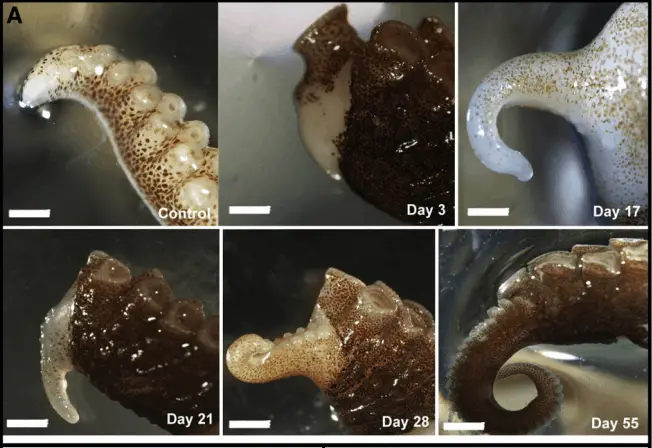
Researchers have observed the following steps in the regenerative process as octopuses regrew severed arms:
First Day: within hours of the damage, the skin at the edges of the wound begins to tighten and pull together to significantly reduce the size of the wound.
Day 3: Within three days the regeneration process begins, and a little knob forms at the point of injury. Biochemicals flood to the wound area and a very thin layer of undifferentiated stem cells covers the knob.
Day 11: A protrusion or ‘blastema’ covers the injury. A blastema is a mass of cells capable of growth and regeneration into organs or body parts.
Day 17: Researchers note that a “hook-like” structure was observed at the wound site, featuring large numbers of stem cells and blood vessels.
Day 28: After a month or so, the knob and hook-like structure have disappeared and are no longer visible.
Day 55: By two months after the injury, all missing components are restored.
Day 100: By around three months after the injury, the entire arm looks complete and has the same strength as the original arm.
The researchers considered the regenerated limb to be as good as new.
One Key Biochemical Involved in Regeneration: AChE
The enzyme acetylcholinesterase or AChE has been shown to have a key role in octopus arm regeneration. This biochemical is used by nerves to send signals across the gap or synapse between one neurotransmitter and another. Any time a nerve is transmitting a signal from the brain to a muscle or vice versa, AChE is being used to get the signal across.
In human terms, when you think of the number of signals our nerves are sending continuously, we realize how crucial this chemical is. AChE is integral to our ability to feel pain (how ironic – ache!). This may not seem all that great at first glance, but, believe me, humans wouldn’t have made it this far without the ability to feel pain.
Octopuses can modulate the flow of AChE, which plays an important role in the regeneration process.
During the octopus arm regeneration process, research shows that AChE levels increase and decrease relative to proximity to the wound and the stage of healing.
In UNINJURED TISSUE, AChE remained strongly associated with the nerves and levels stayed normal.
In DAMAGED ARMS, AChE levels also stayed relatively normal until the third week. Suddenly, at that stage in the healing process, ACHe levels increased dramatically as the suckers and chromatophores started to grow back. ACHe levels were reduced again by day 42 and back to normal by day 130 when regeneration was complete.
The researchers suggest “that AChE protein may have an important influence in the process of regeneration and that it could be considered as a potential target to promote or regulate the regenerative process.”
Hemocytes Also Come Rushing In
Some of the most important findings in the various studies of the regenerative process highlight the role of hemocytes. These are cellular components of the circulatory system that form the basis of the cephalopod immune system and in various phases of the regeneration process. Hemocytes rush to the site of a wound to form a scar and to start cleaning up dying tissue and cellular debris.
The scar tissue provides a protective knob that blocks out pathogens but does not interfere with the regenerative process. Indeed, in the case of an arm wound, this plug contributes to the formation of the primary blastema, thought to supply material for the regenerating stump.
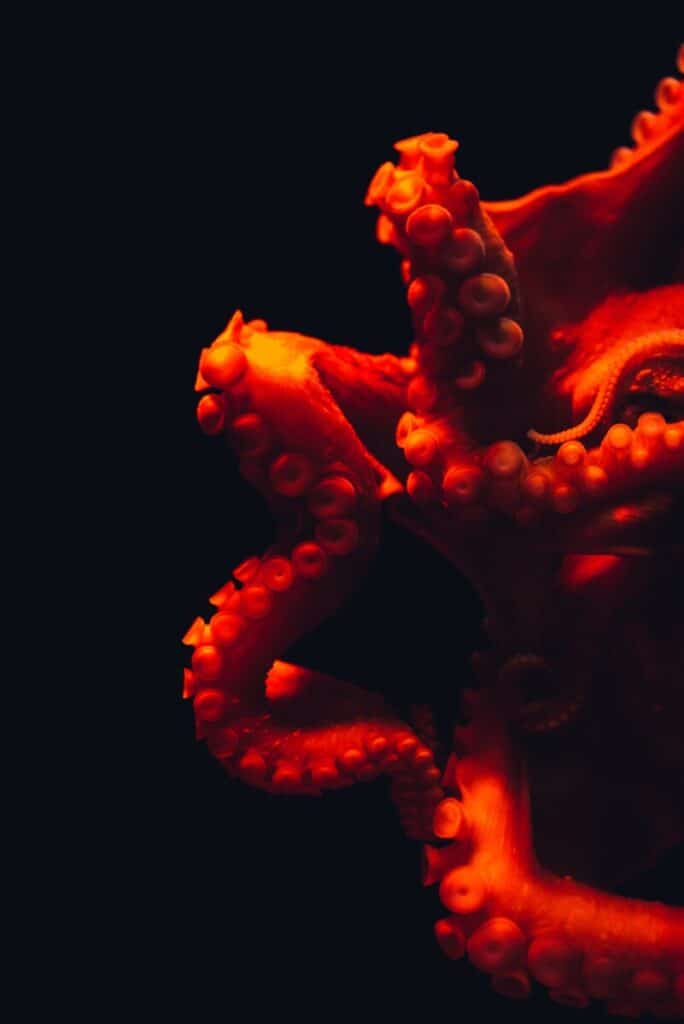
Why Do Octopus Have the Ability to Regenerate an Arm?
Now that we’ve seen how octopus can regenerate limbs, the next question is “how did this ability evolve in the first place?”
Many of the octopus species that we are familiar with lead dangerous lives, usually living and hunting on the ocean floor. Many octopus like rocky or coral encrusted areas and they use their arms for probing and finding food, for capturing prey, and for defense.
One of the octopus’ favorite foods is crab which usually involves frantic claws that fight back! Imagine trying to put a crab out of commission by using bare skin, even if it is backed by hefty muscle!
Fortunately, octopuses are better equipped than we may give them credit for: they have a tough file-like tongue that can penetrate connective tissue, venomous saliva, and a strong parrot-like beak to even the odds.
But you can see how this lifestyle and hunting strategy can create a high risk of damage to an octopus’ arm!
Surveys of octopuses caught in the wild show that arm damage is common. For example, 50 % of the common octopus, O. vulgaris, caught in the Bay of Naples had some damage to one or more arms. Similarly, 26% of Pacific pygmy octopus, Octopus digueti, had arm damage.

The high probability of damage to octopus arms is likely one of the key evolutionary pressures for regeneration.
Octopuses can also remove or cast off their own appendages. This occurs through autophagy where the body metabolizes its own tissue during starvation or illness. This is common with female octopuses after they lay their eggs and spend weeks or months looking after them without feeding the entire time. Female octopus can lose 50% or more of their body mass during this period.
Some octopuses even have the ability to autotomize (cast off) their own appendages when escaping from predators. (For something fascinating read my article about the closely related nautilus and how it can use one of its arms as a detachable penis).
As you can see, vigorous limb regeneration can come in handy – especially if you’re an octopus!
There’s a lot more to these fascinating creatures than you might think! If you are interested in octopus brains and hearts see my article on Why Octopus have 9 Brains and 3 Hearts.

If you are interested in octopus sex and the merits of having a detachable penis, see my related article about octopuses and cannibalistic sex. In case you might be wondering… yes, male octopuses can have an erection. Vital information.
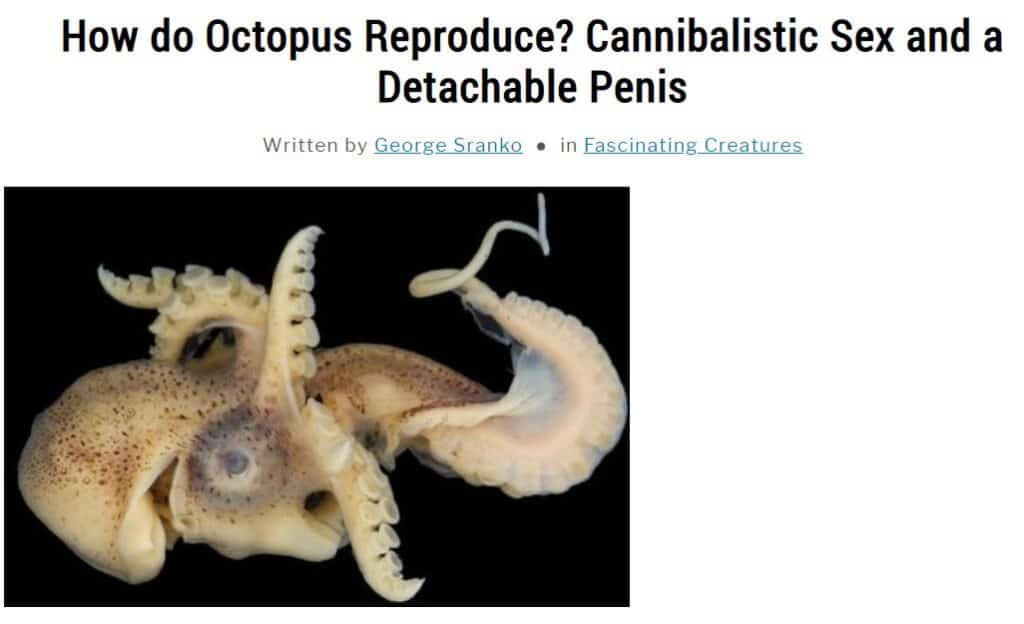
OK – time for some black humor!
Hungry after reading this article?! Severed octopus arms should never go to waste! After ordering octopus in Santorini, one of our favorite meals in the entire world is Greek-style Grilled Octopus! Wonder if the Italian researchers would agree?

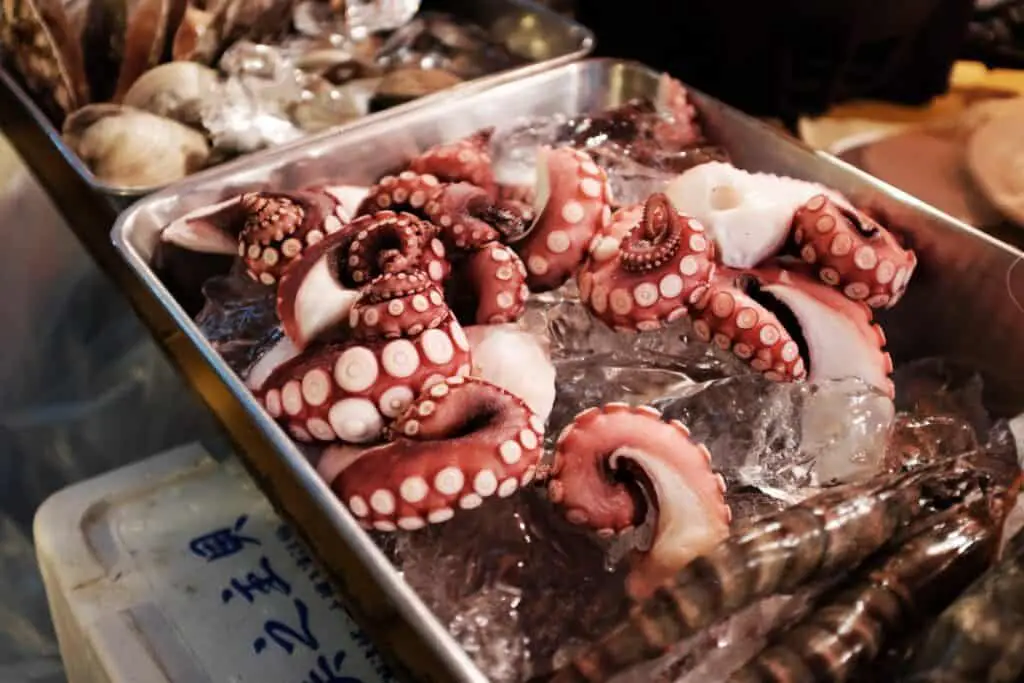
You might want to check out the rest of my series of popular octopus articles:
Why do Octopus have 3 Hearts, 9 Brains, and Blue Blood? Smart Suckers!
How do Octopus Reproduce? (Cannibalistic Sex and a Detachable Penis)
How Smart are Octopuses? Are Octopuses As Intelligent as Dogs?
References
Imperadore, P., & Fiorito, G. (2018). Cephalopod Tissue Regeneration: Consolidating Over a Century of Knowledge. Frontiers in physiology, 9, 593. https://doi.org/10.3389/fphys.2018.00593
Sara Maria Fossati, Francesca Carella, Gionata De Vico, Fabio Benfenati, Letizia Zullo, Octopus arm regeneration: Role of acetylcholinesterase during morphological modification, Journal of Experimental Marine Biology and Ecology, Volume 447, 2013, Pages 93-99, ISSN 0022-0981, https://doi.org/10.1016/j.jembe.2013.02.015
Shaw, T. J., Osborne, M., Ponte, G., Fiorito, G., & Andrews, P. L. (2016). Mechanisms of wound closure following acute arm injury in Octopus vulgaris. Zoological letters, 2, 8. https://doi.org/10.1186/s40851-016-0044-5
Our TOP Articles for Even More Fascinating Creatures
- How do Octopus Reproduce? (Cannibalistic Sex, Detachable Penis)
- Do Jellyfish have Brains? How Can they Hunt without Brains?
- Why are Deep Sea Fish So Weird and Ugly? Warning: Scary Pictures!
- How do Electric Eels Shock Their Prey? Can an Electric Eel Kill You?
- Are Komodo Dragons Dangerous? Where Can you See Them?
- Koala Brains – Why Being Dumb Can Be Smart (Natural Selection)
- Why do Lions Have Manes? (Do Dark Manes Mean More Sex?)
- How Do Lions Communicate? (Why Do Lions Roar?)
- How Smart are Octopuses? Are Octopuses As Intelligent as Dogs?
- How Dangerous are Stonefish? Can You Die if You Step on One?
- What Do Animals Do When They Hibernate? How do they Survive?
- Leaf Cutter Ants – Surprising Facts and Adaptations; Pictures and Videos
- Irukandji Jellyfish Facts and Adaptations; Can They Kill You? Are they spreading?
- How to See MORE Wildlife in the Amazon: 10 Practical Tips
- Is it Safe to go on Safari with Africa’s Top Predators and Most Dangerous Animals?
- What to Do if You Encounter a Bullet Ant? World’s Most Painful Stinging Insect!
- How Do Anglerfish Mate? Endless Sex or Die Trying!
- How Smart are Crocodiles? Can They Cooperate, Communicate…Use Tools?
- How Can We Save Our Oceans? With Marine Sanctuaries!
- Why Are Male Birds More Colorful? Ins and Outs of Sexual Selection Made Easy!
- Why is the Cassowary the Most Dangerous Bird in the World? 10 Facts
- How Do African Elephants Create Their Own Habitat?
- What is Killing Our Resident Orcas? Endangered Killer Whales
- Why are Animals of the Galapagos Islands Unique?
- Where Can You See Wild Lemurs in Madagascar? One of the Best Places
- Where Can You see Lyrebirds in the Wild? the Blue Mountains, Australia
- Keeping Mason Bees as Pets
- Why do Flamingos have Bent Beaks and Feed Upside Down?
- Why are Hippos Dangerous? Why Do They Kill People?
The Gear We Take With Us
We love to travel in search of exceptional wildlife viewing opportunities and for life-enhancing cultural experiences.
Here is the gear we love to travel with for recording our adventures in safety and comfort:
- Action Camera: GoPro Hero10 Black – we find these waterproof cameras are invaluable for capturing the essence of our adventures in video format. Still photos are great, but video sequences with all the sights and sounds add an extra dimension. I use short video clips to spice up many of my audiovisual presentations.
- Drone: DJI Mini 2 SE – this mini drone is made for travel! Roughly the same weight as a smartphone. In the United States and Canada, you can fly this drone without the need to register with local government. Capture on the Go – The lightweight and powerful DJI Mini SE camera drone is the ideal for creators on the move. The ultra-portable design allows you to effortlessly capture unforgettable scenes.
- Long Zoom Camera: Panasonic LUMIX FZ300 Long Zoom Digital Camera – I love this camera for its versatility. It goes from wide angle to 28X optical in a relatively compact design. On safari in Africa I’ve managed to get good shots of lions that the folks with long lenses kept missing – because the lions were too close! I also like the 120 fps slow-motion for action shots of birds flying and animals on the move. I call this my “bird camera.”
- 360 Camera: Insta360 ONE R 360 – 5.7K 360 Degree Camera, Stabilization, Waterproof – see my article How to Take Impossible Shots with Your 360 Camera. This camera is literally like taking your own camera crew with you when you travel! Read my article and you’ll see why.
- Backpack camera mount: Peak Design Capture Clip
- Water Filtration: LifeStraw Go Water Filter Bottle
- Binoculars: Vortex Binoculars or Vortex Optics Diamondback HD Binoculars (good price)

